A Synthetic Landscape Metric to Evaluate Urban Vegetation Quality: A Case of Fuzhou City in China
Abstract
:1. Introduction
2. Materials and Methods
2.1. Study Area
2.2. Data Source and Preprocessing
2.3. Calculation of Urban Vegetation Quality Index
2.3.1. Selection of Representative Metrics
2.3.2. Construction and Testing of Urban Vegetation Quality Index
3. Results
3.1. Scale Effects of the Synthetic Vegetation Quality Index
3.1.1. Correlations between VQI Indicators
3.1.2. Principal Component Analysis
3.2. Validity of the Synthetic Vegetation Quality Index
3.3. Spatiotemporal Characteristics of Vegetation Quality
4. Discussion
5. Conclusions
Author Contributions
Funding
Institutional Review Board Statement
Informed Consent Statement
Data Availability Statement
Conflicts of Interest
References
- Liu, X.; Huang, Y.; Xu, X.; Li, X.; Li, X.; Ciais, P.; Lin, P.; Gong, K.; Ziegler, A.D.; Chen, A. High-spatiotemporal-resolution mapping of global urban change from 1985 to 2015. Nat. Sustain. 2020, 3, 564–570. [Google Scholar] [CrossRef]
- Seto, K.C.; Güneralp, B.; Hutyra, L.R. Global forecasts of urban expansion to 2030 and direct impacts on biodiversity and carbon pools. Proc. Natl. Acad. Sci. USA 2012, 109, 16083–16088. [Google Scholar] [CrossRef] [PubMed] [Green Version]
- Peng, J.; Tian, L.; Liu, Y.; Zhao, M.; Wu, J. Ecosystem services response to urbanization in metropolitan areas: Thresholds identification. Sci. Total Environ. 2017, 607, 706–714. [Google Scholar] [CrossRef] [PubMed]
- Pickard, B.R.; Van Berkel, D.; Petrasova, A.; Meentemeyer, R.K. Forecasts of urbanization scenarios reveal trade-offs between landscape change and ecosystem services. Landsc. Ecol. 2017, 32, 617–634. [Google Scholar] [CrossRef]
- Guo, G.; Wu, Z.; Cao, Z.; Chen, Y.; Zheng, Z. Location of greenspace matters: A new approach to investigating the effect of the greenspace spatial pattern on urban heat environment. Landsc. Ecol. 2021, 36, 1533–1548. [Google Scholar] [CrossRef]
- Alonzo, M.; Bookhagen, B.; McFadden, J.P.; Sun, A.; Roberts, D.A. Mapping urban forest leaf area index with airborne lidar using penetration metrics and allometry. Remote Sens. Environ. 2015, 162, 141–153. [Google Scholar] [CrossRef]
- Escobedo, F.J.; Nowak, D.J. Spatial heterogeneity and air pollution removal by an urban forest. Landsc. Urban Plan. 2009, 90, 102–110. [Google Scholar] [CrossRef]
- McPherson, E.G.; Simpson, J.R.; Xiao, Q.; Wu, C. Million trees Los Angeles canopy cover and benefit assessment. Landsc. Urban Plan. 2011, 99, 40–50. [Google Scholar] [CrossRef]
- Greene, C.S.; Kedron, P.J. Beyond fractional coverage: A multilevel approach to analyzing the impact of urban tree canopy structure on surface urban heat islands. Appl. Geogr. 2018, 95, 45–53. [Google Scholar] [CrossRef]
- Afizzul, M.M.; Yasmin, Y.S.; Hamdan, O. Development of landscape forest performance index to assess forest quality of managed forests. In Proceedings of the IOP Conference Series: Earth and Environmental Science, Kuala Lumpur, Malaysia, 20–21 October 2020; Volumer 540, p. 12012. [Google Scholar] [CrossRef]
- Becker, S.J.; Daughtry, C.S.T.; Russ, A.L. Robust forest cover indices for multispectral images. Photogramm. Eng. Remote Sens. 2018, 84, 505–512. [Google Scholar] [CrossRef]
- Lim, K.; Treitz, P.; Baldwin, K.; Morrison, I.; Green, J. Lidar remote sensing of biophysical properties of tolerant northern hardwood forests. Can. J. Remote Sens. 2003, 29, 658–678. [Google Scholar] [CrossRef]
- Pettorelli, N.; Vik, J.O.; Mysterud, A.; Gaillard, J.-M.; Tucker, C.J.; Stenseth, N.C. Using the satellite-derived NDVI to assess ecological responses to environmental change. Trends Ecol. Evol. 2005, 20, 503–510. [Google Scholar] [CrossRef] [PubMed]
- Myneni, R.B.; Hall, F.G.; Sellers, P.J.; Marshak, A.L. The interpretation of spectral vegetation indexes. IEEE Trans. Geosci. Remote Sens. 1995, 33, 481–486. [Google Scholar] [CrossRef]
- Carlson, T.N.; Ripley, D.A. On the relation between NDVI, fractional vegetation cover, and leaf area index. Remote Sens. Environ. 1997, 62, 241–252. [Google Scholar] [CrossRef]
- Hardin, P.J.; Jensen, R.R. The effect of urban leaf area on summertime urban surface kinetic temperatures: A Terre Haute case study. Urban For. urban Green. 2007, 6, 63–72. [Google Scholar] [CrossRef]
- Cattanio, J.H. Leaf area index and root biomass variation at different secondary forest ages in the eastern Amazon. For. Ecol. Manag. 2017, 400, 1–11. [Google Scholar] [CrossRef]
- Chen, L.; Wang, Y.; Ren, C.; Zhang, B.; Wang, Z. Optimal combination of predictors and algorithms for forest above-ground biomass mapping from sentinel and SRTM data. Remote Sens. 2019, 11, 414. [Google Scholar] [CrossRef] [Green Version]
- Majasalmi, T.; Rautiainen, M. The potential of Sentinel-2 data for estimating biophysical variables in a boreal forest: A simulation study. Remote Sens. Lett. 2016, 7, 427–436. [Google Scholar] [CrossRef]
- Wiggins, H.L.; Nelson, C.R.; Larson, A.J.; Safford, H.D. Using LiDAR to develop high-resolution reference models of forest structure and spatial pattern. For. Ecol. Manag. 2019, 434, 318–330. [Google Scholar] [CrossRef]
- Hu, X.; Xu, H. A new remote sensing index for assessing the spatial heterogeneity in urban ecological quality: A case from Fuzhou City, China. Ecol. Indic. 2018, 89, 11–21. [Google Scholar] [CrossRef]
- Xu, H.; Wang, Y.; Guan, H.; Shi, T.; Hu, X. Detecting ecological changes with a remote sensing based ecological index (RSEI) produced time series and change vector analysis. Remote Sens. 2019, 11, 2345. [Google Scholar] [CrossRef] [Green Version]
- Liu, S.; Li, X.; Chen, L.; Zhao, Q.; Zhao, C.; Hu, X.; Li, J. A New Approach to Investigate the Spatially Heterogeneous in the Cooling Effects of Landscape Pattern. Land 2022, 11, 239. [Google Scholar] [CrossRef]
- Hu, X.; Xu, H. A new remote sensing index based on the pressure-state-response framework to assess regional ecological change. Environ. Sci. Pollut. Res. 2019, 26, 5381–5393. [Google Scholar] [CrossRef] [PubMed]
- Jiménez-Muñoz, J.C.; Sobrino, J.A.; Skoković, D.; Mattar, C.; Cristóbal, J. Land surface temperature retrieval methods from Landsat-8 thermal infrared sensor data. IEEE Geosci. Remote Sens. Lett. 2014, 11, 1840–1843. [Google Scholar] [CrossRef]
- Bodin, Ö.; Saura, S. Ranking individual habitat patches as connectivity providers: Integrating network analysis and patch removal experiments. Ecol. Modell. 2010, 221, 2393–2405. [Google Scholar] [CrossRef]
- Fernandes, M.R.; Aguiar, F.C.; Ferreira, M.T. Assessing riparian vegetation structure and the influence of land use using landscape metrics and geostatistical tools. Landsc. Urban Plan. 2011, 99, 166–177. [Google Scholar] [CrossRef] [Green Version]
- Sowińska-Świerkosz, B.N.; Soszyński, D. Landscape structure versus the effectiveness of nature conservation: Roztocze region case study (Poland). Ecol. Indic. 2014, 43, 143–153. [Google Scholar] [CrossRef]
- Zhou, W.; Huang, G.; Cadenasso, M.L. Does spatial configuration matter? Understanding the effects of land cover pattern on land surface temperature in urban landscapes. Landsc. Urban Plan. 2011, 102, 54–63. [Google Scholar] [CrossRef]
- McGarigal, K.; Marks, B. FRAGSTATS: Spatial Pattern Analysis Program for Quantifying Landscape Structure; U.S. Department of Agriculture, Forest Service, Pacific Northwest Research Station: Corvallis, OR, USA, 1995.
- Liu, J.; Wilson, M.; Hu, G.; Liu, J.; Wu, J.; Yu, M. How does habitat fragmentation affect the biodiversity and ecosystem functioning relationship? Landsc. Ecol. 2018, 33, 341–352. [Google Scholar] [CrossRef]
- Zhou, W.; Pickett, S.T.A.; Cadenasso, M.L. Shifting concepts of urban spatial heterogeneity and their implications for sustainability. Landsc. Ecol. 2017, 32, 15–30. [Google Scholar] [CrossRef]
- Šímová, P.; Gdulová, K. Landscape indices behavior: A review of scale effects. Appl. Geogr. 2012, 34, 385–394. [Google Scholar] [CrossRef]
- Hu, X.; Xu, H. Spatial variability of urban climate in response to quantitative trait of land cover based on GWR model. Environ. Monit. Assess. 2019, 191, 194. [Google Scholar] [CrossRef] [PubMed]
- Seddon, A.W.R.; Macias-Fauria, M.; Long, P.R.; Benz, D.; Willis, K.J. Sensitivity of global terrestrial ecosystems to climate variability. Nature 2016, 531, 229–232. [Google Scholar] [CrossRef] [PubMed] [Green Version]
- Lin, T.; Ge, R.; Huang, J.; Zhao, Q.; Lin, J.; Huang, N.; Zhang, G.; Li, X.; Ye, H.; Yin, K. A quantitative method to assess the ecological indicator system’s effectiveness: A case study of the ecological province construction indicators of China. Ecol. Indic. 2016, 62, 95–100. [Google Scholar] [CrossRef]
- Liu, Y.; Peng, J.; Wang, Y. Application of partial least squares regression in detecting the important landscape indicators determining urban land surface temperature variation. Landsc. Ecol. 2018, 33, 1133–1145. [Google Scholar] [CrossRef]
- Cinelli, M.; Coles, S.R.; Kirwan, K. Analysis of the potentials of multi criteria decision analysis methods to conduct sustainability assessment. Ecol. Indic. 2014, 46, 138–148. [Google Scholar] [CrossRef] [Green Version]
- Norouzian-Maleki, S.; Bell, S.; Hosseini, S.-B.; Faizi, M. Developing and testing a framework for the assessment of neighbourhood liveability in two contrasting countries: Iran and Estonia. Ecol. Indic. 2015, 48, 263–271. [Google Scholar] [CrossRef] [Green Version]
- Taylor, L.; Hochuli, D.F. Defining greenspace: Multiple uses across multiple disciplines. Landsc. Urban Plan. 2017, 158, 25–38. [Google Scholar] [CrossRef] [Green Version]

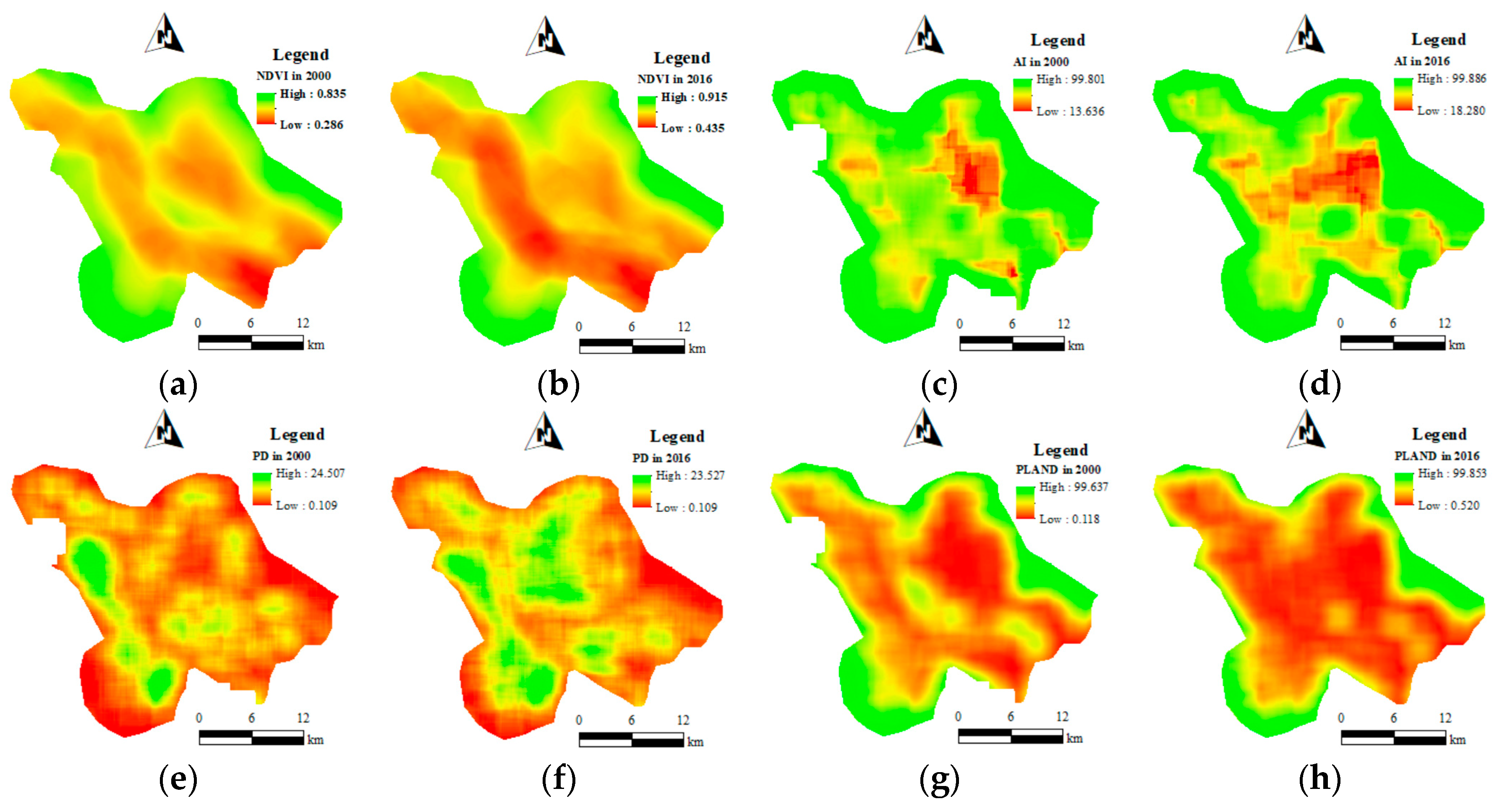
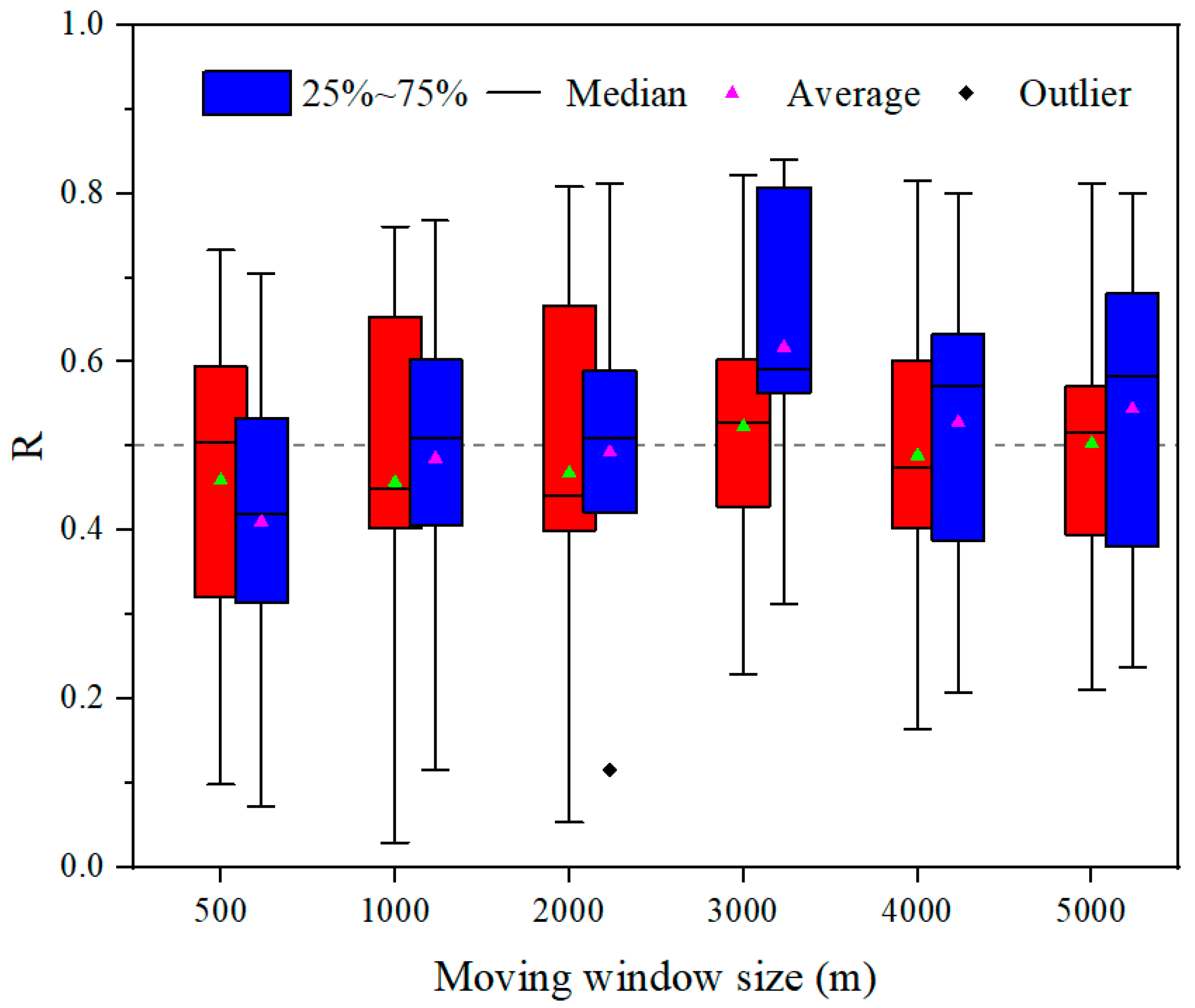

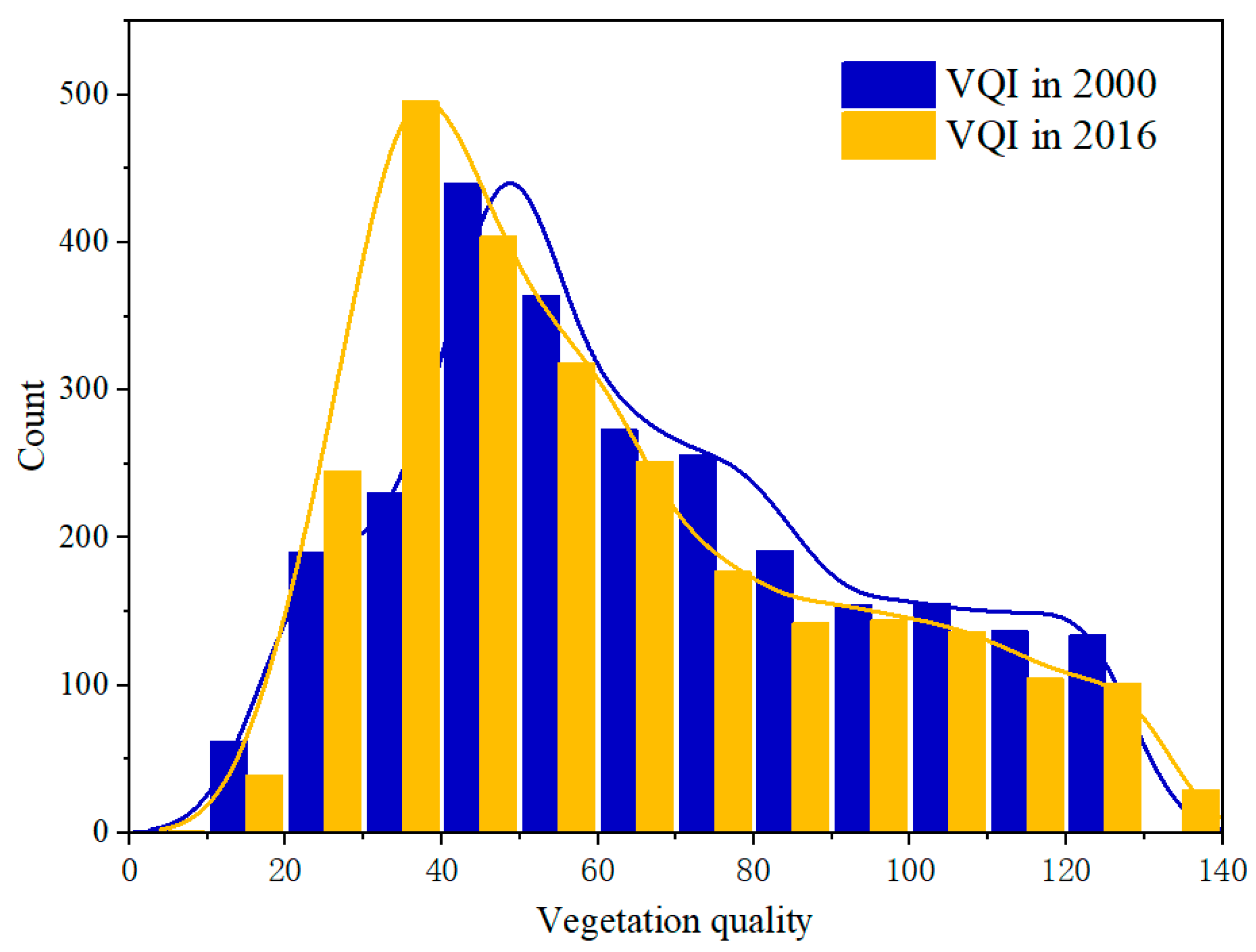

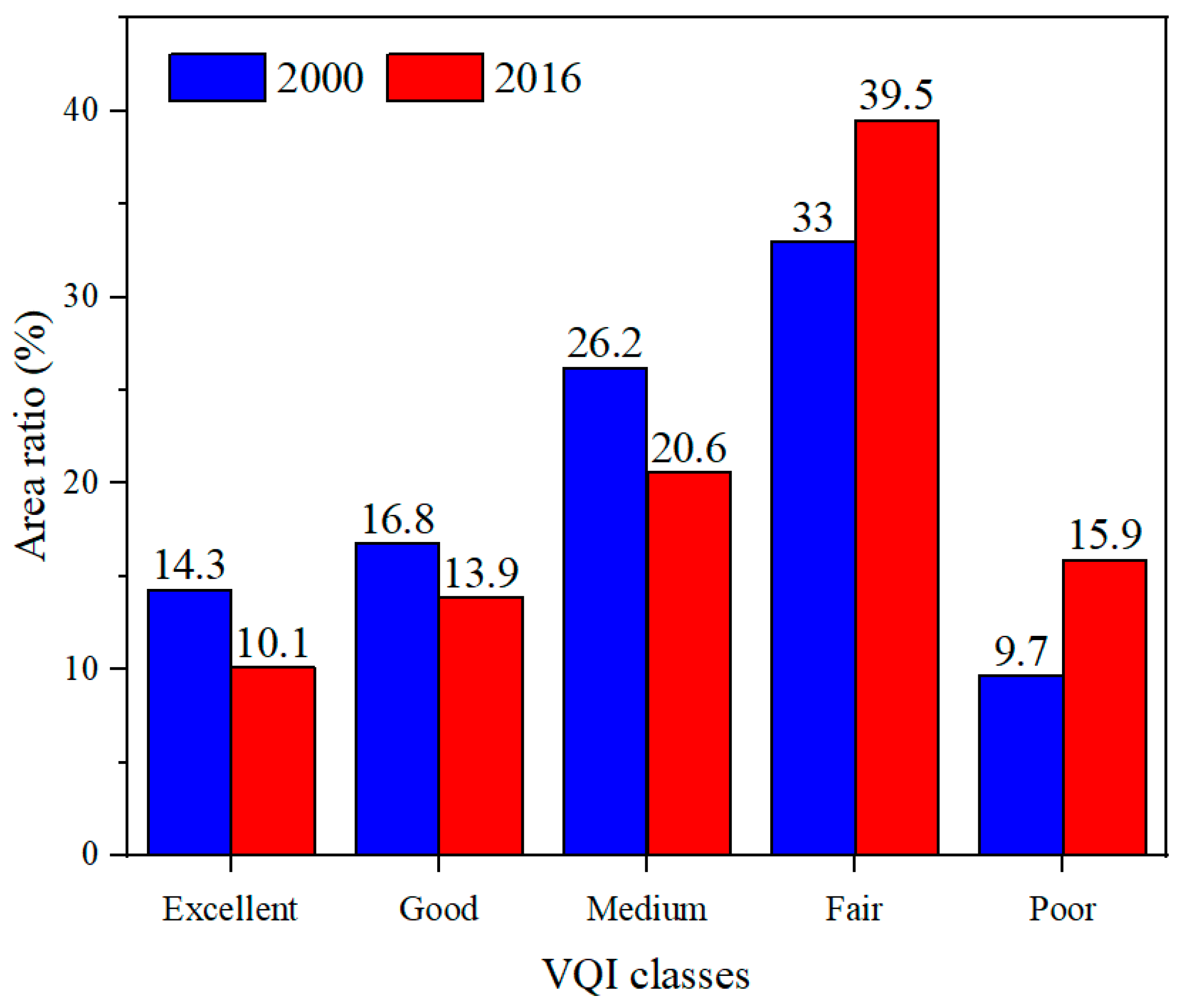
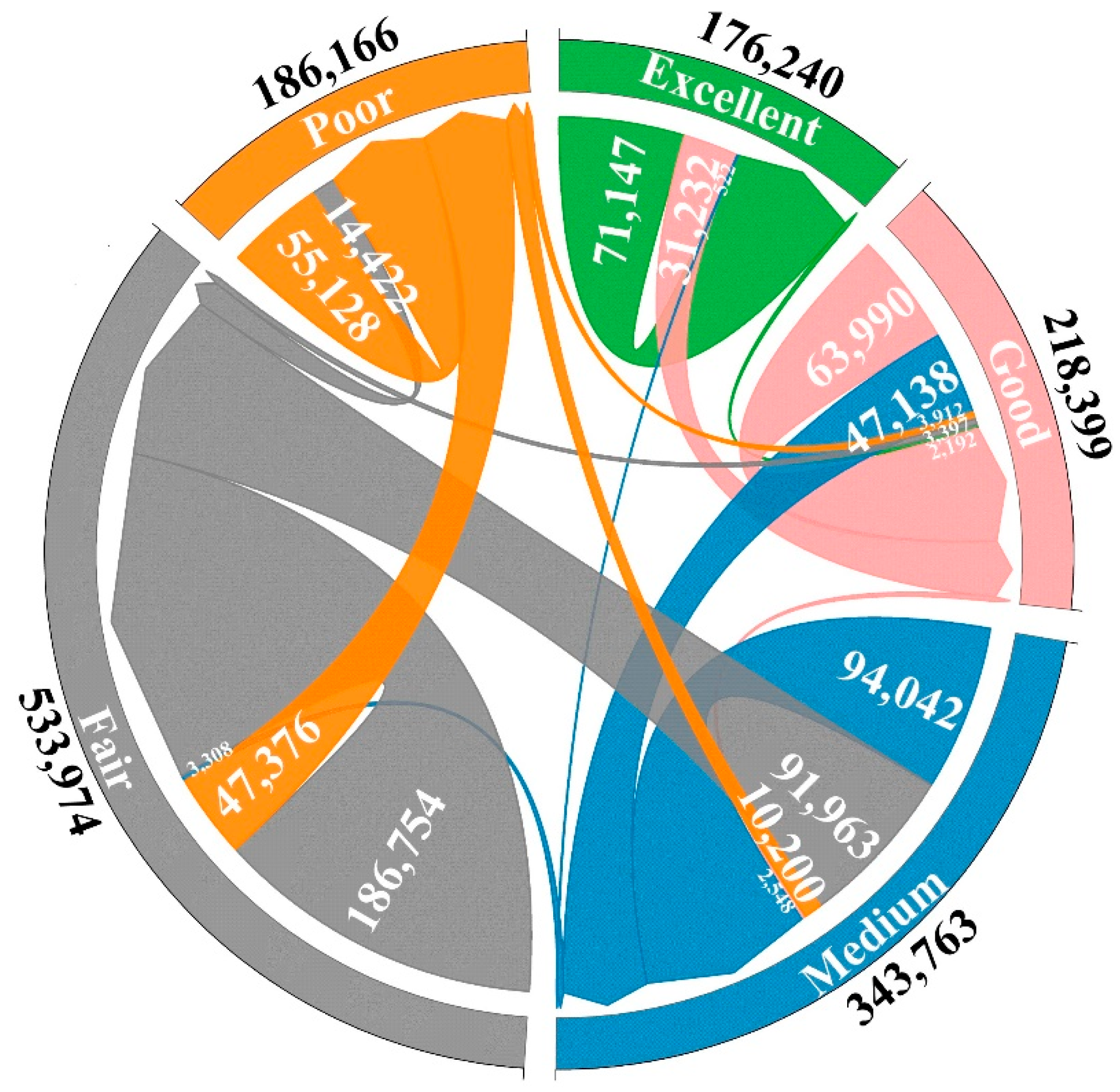
| 2000 | 2016 | |||||||||||
|---|---|---|---|---|---|---|---|---|---|---|---|---|
| AI | PD | PLAND | NDVI | VQI 1 | VQI 2 | AI | PD | PLAND | NDVI | VQI 1 | VQI 2 | |
| Maximum | 99.801 | 24.507 | 99.637 | 0.835 | 128.343 | 1 | 99.886 | 23.527 | 99.853 | 0.915 | 133.269 | 1 |
| Minimum | 13.636 | 0.109 | 0.118 | 0.286 | 4.897 | 0 | 18.280 | 0.109 | 0.520 | 0.435 | 8.217 | 0 |
| Mean | 82.163 | 6.484 | 39.534 | 0.555 | 65.625 | 0.492 | 77.743 | 7.593 | 30.827 | 0.654 | 61.194 | 0.424 |
| SD | 11.887 | 4.096 | 27.130 | 0.102 | 28.992 | 0.235 | 14.812 | 4.169 | 26.611 | 0.104 | 29.515 | 0.236 |
| Window Size | 2000 | 2016 | |||||||
|---|---|---|---|---|---|---|---|---|---|
| Index | PD | PLAND | AI | NDVI | PD | PLAND | AI | NDVI | |
| 500 m | PD | 1.000 | 1.000 | ||||||
| PLAND | −0.462 ** | 1.000 | −0.380 ** | 1.000 | |||||
| AI | −0.594 ** | 0.733 ** | 1.000 | −0.458 ** | 0.706 ** | 1.000 | |||
| NDVI | −0.098 ** | 0.548 ** | 0.321 ** | 1.000 | −0.073 ** | 0.533 ** | 0.314 ** | 1.000 | |
| 1 km | PD | 1.000 | 1.000 | ||||||
| PLAND | −0.417 ** | 1.000 | −0.433 ** | 1.000 | |||||
| AI | −0.482 ** | 0.761 ** | 1.000 | ** | −0.390 ** | 0.768 ** | 1.000 | ||
| NDVI | −0.029 * | 0.653 ** | 0.402 ** | 1.000 | −0.040 ** | 0.603 ** | 0.406 ** | 1.000 | |
| 2 km | PD | 1.000 | 1.000 | ||||||
| PLAND | −0.424 ** | 1.000 | −0.519 ** | 1.000 | |||||
| AI | −0.400 ** | 0.808 ** | 1.000 | −0.502 ** | 0.812 ** | 1.000 | |||
| NDVI | −0.053 ** | 0.666 ** | 0.457 ** | 1.000 | −0.116 ** | 0.590 ** | 0.421 ** | 1.000 | |
| 3 km | PD | 1.000 | 1.000 | ||||||
| PLAND | −0.454 ** | 1.000 | −0.563 ** | 1.000 | |||||
| AI | −0.428 ** | 0.822 ** | 1.000 | * | −0.583 ** | 0.808 ** | 1.000 | ||
| NDVI | −0.229 ** | 0.603 ** | 0.603 ** | 1.000 | −0.312 ** | 0.841 ** | 0.600 ** | 1.000 | |
| 4 km | PD | 1.000 | 1.000 | ||||||
| PLAND | −0.487 ** | 1.000 | −0.600 ** | 1.000 | |||||
| AI | −0.463 ** | 0.815 ** | 1.000 | −0.633 ** | 0.800 ** | 1.000 | |||
| NDVI | −0.163 ** | 0.602 ** | 0.403 ** | 1.000 | −0.207 ** | 0.543 ** | 0.388 ** | 1.000 | |
| 5 km | PD | 1.000 | 1.000 | ||||||
| PLAND | −0.522 ** | 1.000 | −0.642 ** | 1.000 | |||||
| AI | −0.509 ** | 0.812 ** | 1.000 | * | −0.681 ** | 0.801 ** | 1.000 | ||
| NDVI | −0.210 ** | 0.572 ** | 0.394 ** | 1.000 | −0.238 ** | 0.524 ** | 0.381 ** | 1.000 | |
| Window Size | 2000 | 2016 | |||||||
|---|---|---|---|---|---|---|---|---|---|
| Index | PC1 | PC2 | PC3 | PC4 | PC1 | PC2 | PC3 | PC4 | |
| 500 m | PD | −0.142 | −0.409 | 0.901 | −0.004 | −0.108 | −0.156 | 0.982 | −0.004 |
| PLAND | 0.905 | −0.423 | −0.050 | −0.005 | 0.850 | −0.527 | 0.009 | −0.005 | |
| AI | 0.402 | 0.808 | 0.430 | 0.001 | 0.516 | 0.835 | 0.189 | 0.001 | |
| NDVI | 0.003 | −0.004 | 0.003 | 1.000 | 0.003 | −0.004 | 0.003 | 1.000 | |
| Eigenvalue | 685.947 | 72.226 | 27.050 | 0.017 | 767.722 | 111.525 | 33.236 | 0.020 | |
| Percentage eigenvalue (%) | 87.355 | 9.198 | 3.445 | 0.002 | 84.134 | 12.222 | 3.642 | 0.002 | |
| 1 km | PD | −0.092 | −0.217 | 0.972 | −0.008 | −0.083 | −0.003 | 0.997 | −0.009 |
| PLAND | 0.914 | −0.406 | −0.004 | −0.006 | 0.854 | −0.516 | 0.069 | −0.006 | |
| AI | 0.395 | 0.888 | 0.235 | 0.002 | 0.514 | 0.857 | 0.045 | 0.001 | |
| NDVI | 0.004 | −0.005 | 0.008 | 1.000 | 0.004 | −0.004 | 0.010 | 1.000 | |
| Eigenvalue | 673.721 | 55.926 | 19.810 | 0.013 | 725.153 | 77.561 | 19.220 | 0.017 | |
| Percentage eigenvalue (%) | 89.893 | 7.462 | 2.643 | 0.002 | 88.223 | 9.436 | 2.338 | 0.002 | |
| 2 km | PD | −0.070 | −0.054 | 0.996 | −0.011 | −0.083 | −0.044 | 0.996 | −0.012 |
| PLAND | 0.920 | −0.390 | 0.044 | −0.007 | 0.882 | −0.469 | 0.053 | −0.007 | |
| AI | 0.386 | 0.919 | 0.077 | 0.003 | 0.464 | 0.882 | 0.077 | 0.002 | |
| NDVI | 0.004 | −0.006 | 0.011 | 1.000 | 0.004 | −0.005 | 0.012 | 1.000 | |
| Eigenvalue | 566.461 | 33.652 | 11.538 | 0.012 | 572.231 | 42.645 | 9.373 | 0.018 | |
| Percentage eigenvalue (%) | 92.610 | 5.502 | 1.886 | 0.002 | 91.665 | 6.831 | 1.501 | 0.003 | |
| 3 km | PD | −0.066 | −0.055 | 0.996 | −0.005 | −0.084 | −0.090 | 0.992 | −0.005 |
| PLAND | 0.932 | −0.359 | 0.042 | −0.004 | 0.894 | −0.448 | 0.035 | −0.004 | |
| AI | 0.355 | 0.932 | 0.075 | 0.002 | 0.441 | 0.890 | 0.118 | 0.001 | |
| NDVI | 0.003 | −0.004 | 0.005 | 1.000 | 0.003 | −0.003 | 0.005 | 1.000 | |
| Eigenvalue | 454.260 | 21.849 | 7.076 | 0.001 | 480.369 | 34.674 | 6.100 | 0.001 | |
| Percentage eigenvalue (%) | 94.014 | 4.522 | 1.464 | 0.000 | 92.192 | 6.655 | 1.153 | 0.000 | |
| 4 km | PD | −0.065 | −0.065 | 0.996 | −0.009 | −0.085 | −0.102 | 0.991 | −0.011 |
| PLAND | 0.941 | −0.337 | 0.040 | −0.007 | 0.901 | −0.434 | 0.033 | −0.006 | |
| AI | 0.333 | 0.939 | 0.083 | 0.005 | 0.426 | 0.895 | 0.129 | 0.001 | |
| NDVI | 0.005 | −0.008 | 0.009 | 1.000 | 0.004 | −0.005 | 0.011 | 1.000 | |
| Eigenvalue | 389.680 | 17.760 | 4.925 | 0.015 | 420.534 | 30.458 | 4.277 | 0.020 | |
| Percentage eigenvalue (%) | 94.496 | 4.307 | 1.194 | 0.004 | 92.366 | 6.690 | 0.940 | 0.004 | |
| 5 km | PD | −0.066 | −0.086 | 0.994 | −0.007 | −0.087 | −0.112 | 0.990 | −0.011 |
| PLAND | 0.947 | −0.318 | 0.035 | −0.007 | 0.907 | −0.419 | 0.032 | −0.006 | |
| AI | 0.313 | 0.944 | 0.103 | 0.004 | 0.411 | 0.901 | 0.138 | 0.001 | |
| NDVI | 0.005 | −0.007 | 0.007 | 1.000 | 0.005 | −0.004 | 0.011 | 1.000 | |
| Eigenvalue | 332.156 | 14.022 | 3.468 | 0.017 | 370.479 | 25.468 | 3.078 | 0.021 | |
| Percentage eigenvalue (%) | 94.993 | 4.010 | 0.992 | 0.005 | 92.841 | 6.382 | 0.771 | 0.005 | |
| Indicators | Index | AI | PD | PLAND | NDVI | Average 1 |
|---|---|---|---|---|---|---|
| 2000 | R2 | 0.866 ** | −0.469 ** | 0.996 ** | 0.840 ** | 0.793 |
| Moran’s I | 0.828 ** | −0.440 ** | 0.956 ** | 0.822 ** | 0.762 | |
| 2016 | R2 | 0.879 ** | −0.589 ** | 0.991 ** | 0.820 ** | 0.820 |
| Moran’s I | 0.841 ** | −0.561 ** | 0.952 ** | 0.803 ** | 0.789 |
| Year | Indicator | AI | PD | PLAND | NDVI | VQI |
|---|---|---|---|---|---|---|
| 2000 | Pearson correlation | −0.515 ** | 0.179 ** | −0.350 ** | −0.011 | −0.382 ** |
| Moran’s I | −0.508 ** | 0.170 ** | −0.343 ** | −0.047 * | −0.375 ** | |
| 2016 | Pearson correlation | −0.505 ** | 0.454 ** | −0.494 ** | −0.078 ** | −0.515 ** |
| Moran’s I | −0.495 ** | 0.437 ** | −0.479 ** | −0.121 ** | −0.501 ** |
Publisher’s Note: MDPI stays neutral with regard to jurisdictional claims in published maps and institutional affiliations. |
© 2022 by the authors. Licensee MDPI, Basel, Switzerland. This article is an open access article distributed under the terms and conditions of the Creative Commons Attribution (CC BY) license (https://creativecommons.org/licenses/by/4.0/).
Share and Cite
Hu, X.; Xu, C.; Chen, J.; Lin, Y.; Lin, S.; Wu, Z.; Qiu, R. A Synthetic Landscape Metric to Evaluate Urban Vegetation Quality: A Case of Fuzhou City in China. Forests 2022, 13, 1002. https://doi.org/10.3390/f13071002
Hu X, Xu C, Chen J, Lin Y, Lin S, Wu Z, Qiu R. A Synthetic Landscape Metric to Evaluate Urban Vegetation Quality: A Case of Fuzhou City in China. Forests. 2022; 13(7):1002. https://doi.org/10.3390/f13071002
Chicago/Turabian StyleHu, Xisheng, Chongmin Xu, Jin Chen, Yuying Lin, Sen Lin, Zhilong Wu, and Rongzu Qiu. 2022. "A Synthetic Landscape Metric to Evaluate Urban Vegetation Quality: A Case of Fuzhou City in China" Forests 13, no. 7: 1002. https://doi.org/10.3390/f13071002
APA StyleHu, X., Xu, C., Chen, J., Lin, Y., Lin, S., Wu, Z., & Qiu, R. (2022). A Synthetic Landscape Metric to Evaluate Urban Vegetation Quality: A Case of Fuzhou City in China. Forests, 13(7), 1002. https://doi.org/10.3390/f13071002





